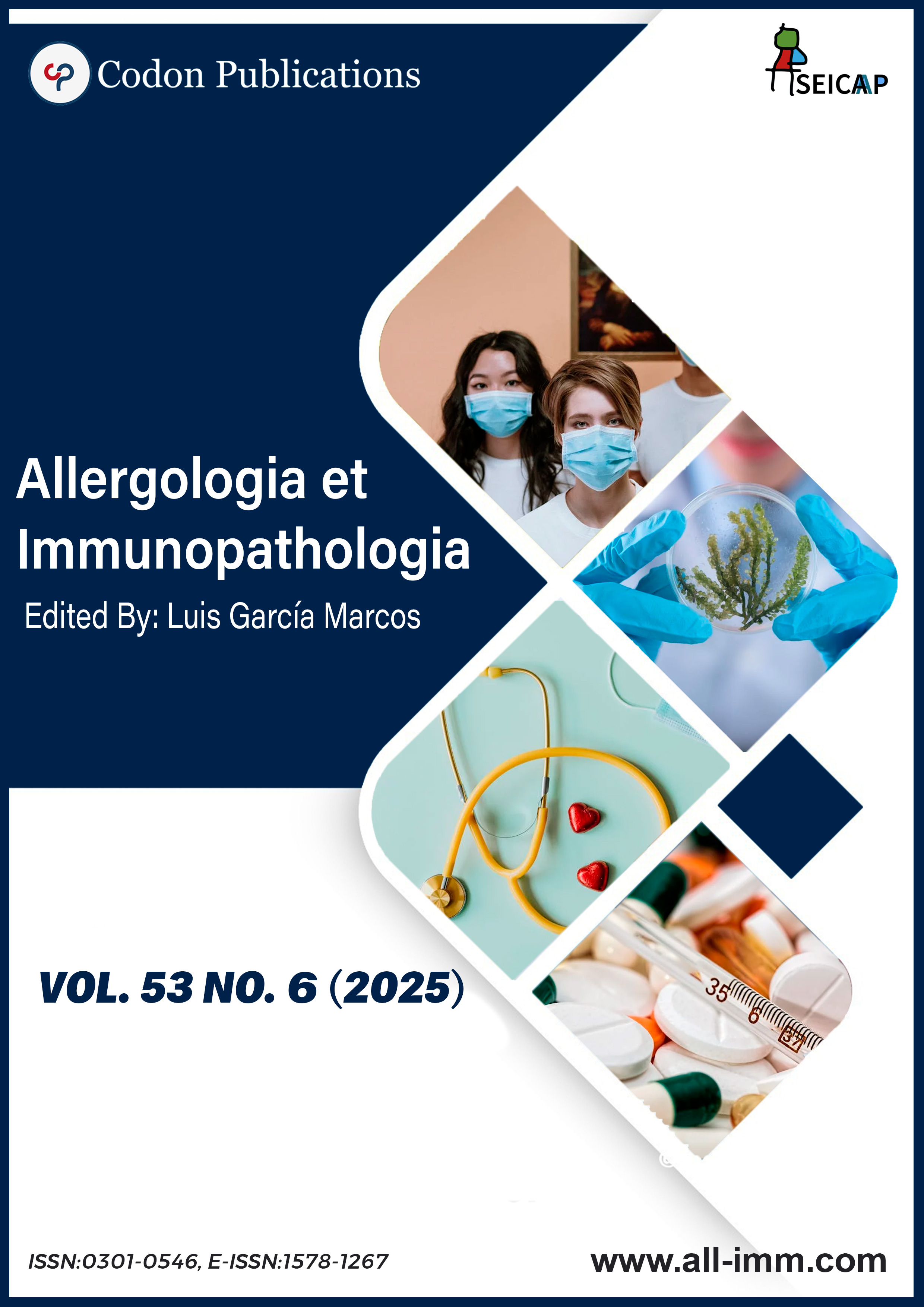Clinical features and treatment outcomes in children with IgG subclass deficiency: A retrospective study
Main Article Content
Keywords
IgG subclass deficiency, IgG3 deficiency, immune profilaxis, immunoglobulin replacement therapy, recurrent infections
Abstract
Introduction: Immunoglobulin G (IgG) subclass deficiencies are among the most common primary immunodeficiencies in children and are associated with increased susceptibility to infections. This study aimed to investigate the clinical features, associated immunological conditions, and treatment outcomes in affected pediatric patients.
Methods: A retrospective analysis was conducted on 43 patients diagnosed with IgG subclass deficiency at the Allergy and Immunology Clinic of Fırat University between January 2019 and July 2024. Clinical records were reviewed for demographic data, immunoglobulin levels, and history of infections. The impact of prophylactic treatments—including intravenous immunoglobulin (IVIG), oral bacterial lysates, and antibiotics—on the frequency of infection was evaluated.
Results: Among the 43 patients, 32 (74.4%) were male and 11 (25.6%) were female, with a mean age at diagnosis of 6.77 ± 2.30 years. The most common clinical presentation was recurrent upper respiratory tract infections, reported in 23 patients (53.5%). Isolated IgG3 deficiency was identified in 34 patients (79.1%). During follow-up, normalization of IgG levels was achieved in 39 patients (90.7%), with a mean time to normalization of 2.1 ± 1.19 years. Prophylactic interventions significantly reduced the annual infection rate from 18.12 ± 10.37 to 3.09 ± 2.40 (p < 0.001).
Conclusion: IgG subclass deficiencies represent a significant health concern in children because of their association with recurrent infections. Early diagnosis and the implementation of appropriate prophylactic treatment strategies are crucial in reducing infection frequency and improving the quality of life. However, the retrospective nature of the study and the relatively small sample size may have limited the evaluation of clinical outcomes and treatment responses, potentially affecting the generalizability of the results. Despite these limitations, the findings highlight the potential benefits of prophylactic interventions in managing infections among children with IgG subclass deficiencies and emphasize the need for larger, prospective studies to inform evidence-based therapeutic strategies for this population.
References
2 Skvaril F, Morell A, Perret B, editors. Clinical Aspects of IgG Subclasses and Therapeutic Implications. 1988; Basel: Karger.
3 Yount WJ, Hong R, Seligmann M, Good RA, Kunkel HG. Imbalances of gamma globulin subgroups and gene defects in patients with primary hypogammaglobulinemia. J. Clin. Invest. 1970 Nov 49(11):1957–66. 1172/JCI106441
4 Schur PH, Borel H, Gelfand EW, Alper CA, Rosen FS. Selective gamma-G globulin deficiencies in patients with recurrent pyogenic infections. N. Engl. J. Med. 1970 Sep 17;283(12): 631–4. 10.1056/NEJM197009172831205
5 Oxelius VA. Chronic infections in a family with hereditary deficiency of IgG2 and IgG4. Clin. Exp. Immunol. 1974 May 17(1): 19–27. 10.1111/j.1365-2249.1974.tb00269.x
6 Plebani A, Carbonara A, Bottaro A, Gallina R, Boccazzi C, Crispino P, et al. Two siblings with deficiency of IgA1, IgG2, IgG4 and IgE due to deletion of immunoglobulin heavy chain constant region genes. Clin. Exp. Immunol. 1993;93(2):231–5. 10.1111/j.1365-2249.1993.tb05512.x
7 Shackelford PG, Granoff DM, Madassery JV, Scott MG, Nahm MH. Clinical and immunologic characteristics of healthy children with subnormal serum concentrations of IgG2. Pediatr Res. 1990 Jan;27(1):16–21. 10.1203/00006450-199001000-00004
8 Wahn V and von Bernuth H. IgG subclass deficiencies in children: facts and fiction. Pediatr. Allergy Immunol. 2017 Sep 28(6):521–4. 10.1111/pai.12746
9 Karaca NE, Karadeniz C, Aksu G, Kutukculer N. Clinical and laboratory evaluation of periodically monitored Turkish children with IgG subclass deficiencies. Asian Pac. J. Allergy Immunol. 2009 Mar 27(1):43–51.
10 Atkinson AR and Roifman CM. Low serum immunoglobulin G2 levels in infancy can be transient. Pediatrics. 2007 Sep;120(3):e543–7. 10.1542/peds.2006-3466
11 Buckley RH. Immunoglobulin G subclass deficiency: fact or fancy? Curr. Allergy Asthma Rep. 2002 Oct 2(5):356–60. 10.1007/s11882-002-0059-3
12 Horton N, Wu X, Philpott J, Garber A, Achkar JP, Brzezinski A, et al. Impact of low immunoglobulin G levels on disease outcomes in patients with inflammatory bowel diseases. Clin. Gastroenterol. Hepatol. 2016 Dec 14(12):3270–7. 10.1016/j.cgh.2016.06.013
13 Go T. Carbamazepine-induced IgG1 and IgG2 deficiency associated with B cell maturation defect. J. Clin. Immunol. 2004 May 24(3):187–90. 10.1023/B:JOCI.0000024992.54445.1c
14 Visitsunthorn N, Hengcrawit W, Jirapongsananuruk O, Luangwedchakarn V. Immunoglobulin G (IgG) subclass deficiency in Thai children. Asian Pac. J. Allergy Immunol. 2011 Dec 29(4):332–8.
15 Kutukculer N, Karaca NE, Demircioglu O, Aksu G. Increases in serum immunoglobulins to age-related normal levels in children with IgA and/or IgG subclass deficiency. Pediatr. Allergy Immunol. 2007 May 18(2):167–73. 10.1111/j.1399-3038.2006.00404.x
16 Read G and Williams P. Evaluation of assays of serum IgG subclasses and IgG antigen-specific antibodies in the investigation of recurrent infection. Ann. Clin. Biochem. 2000 May 37(3):326–9. 10.1258/0004563001899432
17 European Society for Immunodeficiencies. IgG subclass diagnostic criteria. 2024. Available from: https://esid.org/Education/Diagnostic-Criteria-PID.
18 Schur PH. IgG subclasses: a historical perspective. Monogr. Allergy. 1988;23:1–11.
19 Vidarsson G, Dekkers G, Rispens T. IgG subclasses and allotypes: from structure to effector functions. Front. Immunol. 2014; 5:520. 10.3389/fimmu.2014.00520
20 Schatorjé EJ, de Jong E, van Hout RW, Driessen GJ, van der Burg M, Wulffraat NM, et al. The challenge of immunoglobulin-G subclass deficiency and specific polysaccharide antibody deficiency: a Dutch pediatric cohort study. Clin. Exp. Immunol. 2016;184(2):226–34. 10.1111/cei.12751
21 Kocaoğlu M, Kocaoğlu BE, Aytekin SE, Karabulut E, Karakaya G, Kalyoncu AF. Clinical and laboratory evaluation of Turkish children with IgG subclass deficiency. Turk J Pediatr. 2022;64(1):38–45. 10.24953/turkjped.2021.06.006

